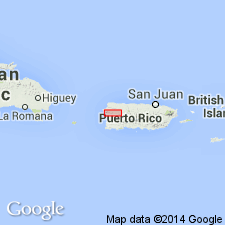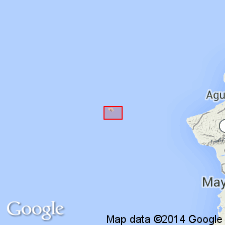
- Usage in publication:
-
- Rio Culebrinas Formation*
- Modifications:
-
- Revised
- Redescribed
- Reference
- AAPG geologic province:
-
- Caribbean region
Summary:
Rio Culebrinas Formation adopted and redefined. Contains 4 lithic types: basal mudstone and limestone here named Guacio Member; tuff breccia; crystal-lithic tuff; and volcanic sandstone and mudstone that form the bulk of the unit. Three upper lithic types grade into one another and are interbedded at all scales. Conformably overlies Mal Paso Formation; unconformably underlies Rio Guatemala Group. Age is middle Eocene based on Foraminifera. Contact between rocks of the Rio Culebrinas and underlying Milagros Formation in the eastern San Sebastian and Bayaney quadrangles is conformable and gradational. The Guacio Member of the Rio Culebrinas, always present at the base of the Rio Culebrinas to the southwest, is not present where the Rio Culebrinas rests on the Milagros. The Milagros may be in part equivalent to the lower part of the Rio Culebrinas of the southern area. Early middle Eocene Foraminifera collected from the Matilde Formation which underlies the Milagros, support this interpretation and indicate that the Milagros is probably middle Eocene, same as the Rio Culebrinas. An unconformity between Cretaceous and middle Eocene rocks is recognized in west-central PR. The unconformity may also be present in northwestern PR as Paleocene and possibly lower Eocene rocks are missing there.
Source: GNU records (USGS DDS-6; Reston GNULEX).

- Usage in publication:
-
- Rio Culebrinas Formation*
- Modifications:
-
- Revised
- AAPG geologic province:
-
- Caribbean region
Summary:
This study shows that the rocks on Isla Desechio are not part of the Yauco Mudstone of Late Cretaceous age, but are of Eocene age and correlate with the lower Tertiary sequence of McIntyre and others (1970), and most probably with the Rio Culebrinas Formation, but correlation with the Concepcion is also possible. They are assigned to the Rio Culebrinas(?) Formation [and the Rio Culebrinas is assigned to the Jacaguas Group]. Thickness is 700 to 1,100 m. Age is middle Eocene.
Source: GNU records (USGS DDS-6; Reston GNULEX).

- Usage in publication:
-
- Rio Culebrinas Formation*
- Modifications:
-
- Overview
- AAPG geologic province:
-
- Caribbean region
Summary:
The Rio Culebrinas Formation occurs in southwestern Puerto Rico and consists of a basal mudstone and limestone followed by breccia, tuff, and volcanic sandstone and mudstone. Maximum estimated thickness is 3000 meters. The Rio Culebrinas is of middle Eocene age.
Source: GNU records (USGS DDS-6; Reston GNULEX).
For more information, please contact Nancy Stamm, Geologic Names Committee Secretary.
Asterisk (*) indicates published by U.S. Geological Survey authors.
"No current usage" (†) implies that a name has been abandoned or has fallen into disuse. Former usage and, if known, replacement name given in parentheses ( ).
Slash (/) indicates name conflicts with nomenclatural guidelines (CSN, 1933; ACSN, 1961, 1970; NACSN, 1983, 2005, 2021). May be explained within brackets ([ ]).

